
WEALTHY WINERIES ROUTINELY ENDANGER WORKERS By David Bacon , Truthout, August 27, 2024 https://truthout.org/articles/californias-wealthy-wine-industry-routinely-endangers-health-of-its-workers/ https://davidbaconrealitycheck.blogspot.com/2024/08/wealthy-wineries-routinely-endanger.html Between wildfires and immigration status, California vineyard workers contend with a host of hurdles to their health. 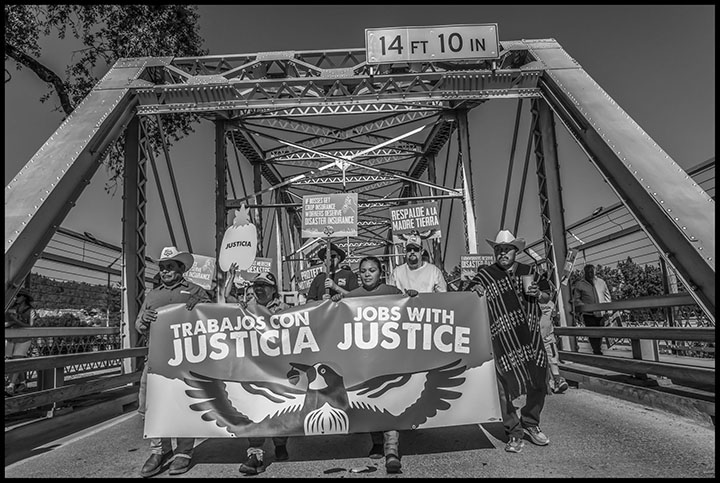 Farmworkers and their supporters occupy a highway bridge during their march demanding pay for working during wildfires. David Bacon From mid-August through mid-November, the grape harvest in California's North Bay wine country coincides with the state's wildfire season. Every night at midnight during those 12 weeks, workers in bandanas and face masks walk quickly into the vineyards. For the next eight or 10 hours, as the darkness slowly becomes dawn, they practically run down the rows. Their curved knives cut grape bunches from the vines, dropping them into the pails held by harnesses to their chests. When the pails are full, the workers rush to the gondolas behind the slow-moving tractors, dump in the grapes, and hurry back to fill them again. The air fills with dust from feet and machines. But often a wildfire, grown huge at the end of a dry summer, casts a pall of smoke that can extend for dozens of miles. When it reaches the vineyards in Sonoma and Napa Counties, smoke combines with dust and it's hard to breathe. "Even my saliva turns black," says Maria Salinas, who has picked wine grapes for 20 years in Sonoma County. The danger of wildfire smoke comes from its fine particles, which lodge themselves so deeply in the lungs that the body can't easily expel them, causing shortness of breath, asthma, heart disease, and other illnesses. A study published in June 2024 has documented 2,305 premature deaths from wildfire smoke in Sonoma County, and 693 in Napa County, between 2008 and 2018. For the farmworkers in the vineyards, however, the smoke and dust compound existing endemic health problems. The social determinants of their health - the way that their well-being is impacted by the economic and social forces acting on them - include the conditions at work, like the wildfire smoke they inhale. Poverty can also have a tremendous impact. The Rural Health Information Hub lists many potential complications from the living and working conditions of farmworkers, including heat-related illness, pesticide exposure, job injuries, urinary tract infections because of the lack of toilet facilities, high disease rates from tuberculosis and COVID caused by crowded living conditions, and depression due to poverty and stress. Maria Salinas's experience shows the way these conditions pile up. She arrived in the U.S. in 2002 from her Chatino-speaking hometown in Oaxaca, Santos Reyes Nopala. "When I started work in the grapes, there was a lot of injustice," she remembers. "It's been 20 years of humiliation. We didn't have water or bathrooms. When I had to urinate, I had to go at the edge of the field. My father worked in the fields for 14 years, and died of cancer of the stomach." California state law has mandated employers provide bathrooms and water in the field for years, but Salinas says that it took worker pressure on the county to get enforcement. "It's gotten better, but now the smoke is on top of all of this. My allergies have turned into asthma and I have to use an inhaler. I've had to go to the emergency room because I couldn't breathe. I'm afraid that if I keep working in these conditions, I'll have permanent damage. But I have a family to support." A few years ago, Salinas went to a meeting to hear a professor from Berkeley explain the dangers of the smoke, where she met Max Bell Alper, the executive director of North Bay Jobs with Justice (JwJ). "We had intense fires in 2017," Alper said, "and fires every year until 2020, when it was really bad. We started training farmworkers to survey their communities, to get people's experiences and find out what they wanted to do about it."  Max Bell Alper, executive director of North Bay Jobs with Justice, speaks at a rally in Healdsburg, California, on July 28, 2024.David Bacon Alper and JwJ trained an equipo, or team, of farmworker organizers, and began holding broader meetings, which organized workers based on their employers, as well as their family and hometown networks. Maria Salinas became one of those equipo organizers. Because most farmworkers in the North Bay come from Indigenous Mexican communities, the surveys and work that came out of them had to be done in their original languages. The broader meetings of workers decided on five basic demands to make of the area's wineries and grape growers: provide clean bathrooms and water; hazard pay; disaster insurance to ensure income if workers were sent home; community safety observers to monitor conditions in the fields; and communication in the workers' own languages. These demands were based on the fact that growers are sending workers into the vineyards even during wildfires, although evacuation orders mandate that people leave because of the danger. In 2022, the workers, along with Jobs with Justice, took those demands to the Sonoma County Board of Supervisors. They asked the county to make their demands requirements for growers who ask permission to send workers to harvest in wildfire evacuation zones. Many of the wineries, however, balked at the demands. To them, the effort would mean not only an increase in their costs, but also signaled the potential danger of organized workers advocating for change. In response, they brought in a notorious union-buster, Raul Calvo. As The Guardian reported in 2022, Calvo played a key role in bringing pro-company workers to testify to the county against the proposal, wearing t-shirts saying "NB [North Bay] JwJ does NOT Speak for Me." Alper charges that many of the workers brought by Calvo were working on H-2A visas. The H-2A program allows growers to recruit workers in Mexico, bring them to the U.S. under contracts which last just for a season, and then send them back. H-2A visa holders must apply to come back every year. They can be legally fired and blacklisted if they don't work fast enough or incur the displeasure of the grower for any reason. Alper says the U.S. Department of Labor, which administers the program, later told growers they could no longer bring H-2A workers to testify in government meetings. Nevertheless, he charges, Calvo continues to conduct captive audience meetings at local vineyards. Workers are required to attend, and to listen to harangues about the dangers of unions and worker organizing. (Calvo did not respond to Truthout's multiple requests for comment.) Despite the growers' opposition, however, the United Farm Workers has negotiated hazard pay into labor contracts with Gallo of Sonoma, Boeschen Vineyards and Robert Mondavi Winery, and disaster insurance to compensate workers for wages lost due to fires. This year, workers have focused their demands on the basic economics of the vineyard labor system, the source of the poverty among farmworker families. Each year, before picking starts, growers tell their crews the price they intend to pay for each ton of grapes, and the basic hourly rate that is the guaranteed minimum compensation. The price varies by company and the variety of grapes, but Salinas says that last year it went from about $150 to $200 per ton. "This year they're offering a 10 percent increase, which is not enough," she says. "Sonoma County is very expensive and gas and groceries are going up all the time." To reinforce the workers' demands, at the end of July, North Bay Jobs with Justice organized a march in Healdsburg, the heart of the Sonoma County wine country. The demonstration demanded a "Sueldo Digno," or decent wage, of $250/ton with a guarantee of $25 per hour. 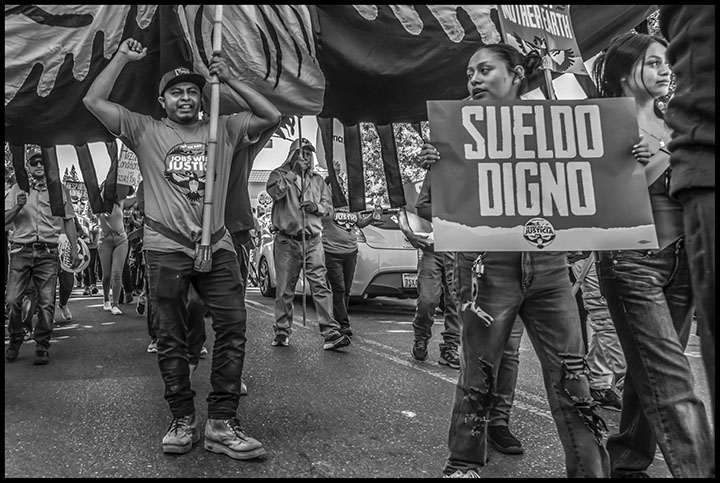 Marchers demand a sueldo digno, or decent wage, for the farmworkers who pick wine grapes in Sonoma and Napa Counties.David Bacon  March banners demand a sueldo digno (a decent wage) and pago por disastre (extra pay) for working during wildfires or losing work when the grape picking stops because of the danger, in Healdsburg, California, on July 28, 2024.David Bacon In 2022, the price growers received for a ton of grapes in Napa County ranged from $2,815 for pinot noir to $8,813 for cabernet sauvignon, for an average of $5,814. Sonoma County prices were somewhat less. At an average picking price of $150 a ton, workers were making 2.5 percent of what growers were getting. Last year, California Sen. Alex Padilla and Sonoma County Congressman Mike Thompson introduced a bill to compensate growers for smoke damage from wildfires to the grapes, but the bill contained nothing to compensate workers for their lost wages or health impacts. The lack of acknowledgment in protections around wildfires mirrors what workers went through during the height of the pandemic. "They called us essential workers, and wanted us to work in the smoke, and every day we were in danger of getting sick from the COVID," Salinas recalls. People went to work because they couldn't afford not to go - just one day without pay could be difficult, and a week ruinous. Often that meant traveling in a packed car or labor contractor bus, and returning home to a crowded house shared by more than one family. Not only was isolation impossible, but the cost of acknowledging an infection could potentially cut others off from their jobs and source of income. "Undocumented farmworkers with mild cases of COVID-19 were also reluctant to self-isolate, because they were ineligible for both unemployment insurance and CARES Act-funded pandemic assistance," health researcher Ed Kissam told Truthout. "In addition, people worried about the government using personal information for immigration enforcement." 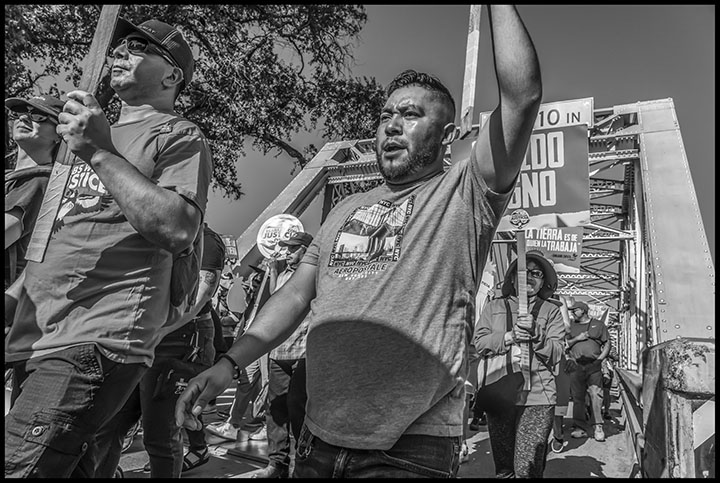 Wine grape workers march demanding a sueldo digno, or decent wage, in Healdsburg, California, on July 28, 2024.David Bacon  Farmworker supporter Larry Bogad performs as a dueno, or vineyard owner, in a teatro during a march demanding disaster and hazard pay for working during wildfires.David Bacon As a result, Alicia Riley, a health sociologist at the University of California in Santa Cruz, reported that COVID deaths of people employed in agriculture were about 1.6 times the national average in 2020. According to a report by the California Institute for Rural Studies, between March and June of 2020, agricultural workers in Monterey County contracted COVID-19 at three times the rate of workers in other industries. Some 583 people died in Sonoma County from the virus, and 174 in Napa County. Arcenio Lopez, director of the Mixteco Indigena Community Organizing Project, explains, "People come to the U.S. and work for years and still can't access health care. What determines whether they can get it are the priorities of the family. The first priority is to pay the rent, then to buy food and clothes. Health is not a priority because their economy doesn't permit it." "Most farmworkers are long-term settled immigrants in low-income households that include undocumented immigrants," Kissam added. "Their eligibility is compromised for a broad range of social programs because they're conditioned on immigration status." Despite the state's extension of Medicaid coverage to undocumented people last year, about half of all farmworkers in California, and 62 percent of undocumented farmworkers, still have no medical insurance, a far greater percentage than in the general population. Lack of immigration status is one of the most important social determinants of farmworker health. The Sonoma and Napa County wine industry, like the rest of California agriculture, has always depended on immigrant labor. Ninety percent of California's farmworkers are immigrants, and more than half are undocumented. It's for this reason that farmworkers are organizing around immigration, too. Maria Salinas and Max Bell Alper were among several hundred activists who gathered last August in Petaluma's Walnut Park, in Sonoma County's wine country. After listening to a few speeches and cheering on a local troupe of Aztec dancers, they set off on a three-day march to the San Francisco Federal Building. Their goal was to win support for a bill that could make a profound difference in the life of North Bay farmworkers. Currently, anyone who entered the U.S. without a visa before January 1, 1972, can apply for legal permanent residence status, known as a green card. After five years as a legal resident, they can then apply for U.S. citizenship. Unfortunately, for the estimated 11 million undocumented immigrants living in the U.S., only a tiny handful qualify under that registry date. "Ninety percent of currently undocumented people is probably an underestimate," says Renee Saucedo, who helped organize the Northern California Coalition for Just Immigration Reform, and annual marches to support changing the registry date. HR 1511, "Renewing Immigration Provisions of the Immigration Act of 1929," known as the Registry Bill, would allow anyone in the country for seven years to apply for a green card. Many grassroots activists believe that fighting for the registry bill is also a way to mobilize communities in their own defense, over an issue that has a dramatic impact on community health. "I was really proud to be part of that march," Salinas remembers. "I was very angry, and it gave me a way of fighting for my children, so they don't have to endure what I did, and for a world that will respect their rights." 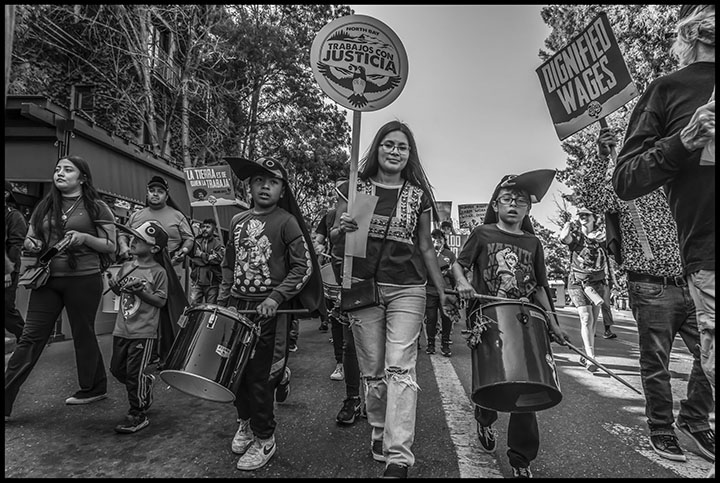 A mom and her kids march for farmworker justice, in Healdsburg, California, on July 28, 2024.David Bacon WORKING COACHELLA INTERVIEW WITH DAVID BACON AT THE WORKING COACHELLA EXHIBITION IN RIVERSIDE David Bacon's Working Coachella - Labor Heritage Power Hour with Chris Garlock https://www.listennotes.com/podcasts/labor-heritage/david-bacons-working-coachella-FGTeo-nqcuX/ Presentation by David Bacon and Ann Lewis about the politics of the "immigration crisis" Http://ouleft.org/wp-content/uploads/4thmonda-immigration-bacon-lewis.mp4 BROOKE ANDERSON PODCAST #8 David came up as a union organizer with the United Farm Workers and United Electrical Workers, then spent decades as a photographer, photojournalist, labor reporter, and radio host covering labor, migration, and global economy. In this week’s episode, we talk David’s journey from organizer to photojournalist, his early influences, the role of movement photographers, the importance of media workers taking collective action to support their labor rights, journalists speaking out to support a ceasefire in Gaza, and advice for new photographers developing their photographic practice. MAS QUE UN MURO Las comunidades fronterizas y sus movimientos de justica social Fotografias de David Bacon Fototeca de Zacatecas Pedro Valtierra Fernando Millapando 406, Centro Historico, Zacatecas Marzo - Mayo, 2024 Cinco Entrivistas sobre esta exposicion, en el Museo Nacional de las Culturas del Mundo, CDMX: Part 1: https://www.youtube.com/watch?v=6eix0HEStpc Part 2: https://www.youtube.com/watch?v=FO4IIBPs06U Part 3: https://www.youtube.com/watch?v=VHtY-fgtsjs Part 4: https://www.youtube.com/watch?v=Xm_MNrEX2Mw Part 5: https://www.youtube.com/watch?v=MpwSuBbgAQs La imagen de una cruz en el cementerio de Holtville, en California, Estados Unidos, con la leyenda “No olvidados”, con la que activistas religiosos reconocen a los migrantes muertos sin identidad, recibe al público de la exposición Más que un muro, de David Bacon. Durante la inauguración, la directora del MNCM, Alejandra Gómez Colorado, manifestó que, desde hace años, este recinto complementa su discurso histórico y etnográfico con reflexiones que vienen desde la fotografía y el arte contemporáneo. Una línea acorde con el trabajo de Bacon, “una expresion dura y cruda de la vida que transcurre de uno y otro lado de la frontera México-Estados Unidos”. Esta obra fotográfica dijo por su parte la jefa de la Unidad de Política Migratoria, Registro e Identidad de Personas, de la Segob, Rocío González Higuera, permiten acercarse a las historias, retos, éxitos y fracasos de cada persona que migra, desde dos puntos: “El primero, la protección de la memoria contra el paso del tiempo, es decir, colocar la lente y los sentimiento sobre objetos y personas que nos permiten evocar que la frontera es un cúmulo de historias en desarrollo; el segundo, es la expresión de posturas frente a los procesos de movilidad, particularmente la migración irregular”. Bacon, fotógrafo, escritor y activista social, comenzó a documentar las vidas y los movimientos sociales de migrantes, trabajadores agrícolas y comunidades afectadas por la globalización, hace casi cuatro décadas. El fotógrafo detalló que su aproximación a estas realidades inició en 1986, siendo trabajador de una fábrica y sindicalista con United Farm Workers. A lo largo de este tiempo, indicó, ha podido registrar cómo la política migratoria implementada por su país devino en una “política de muerte”, al orillar a quienes buscan el sueño americano a transitar por sitios peligrosos como el desierto de Sonora-Arizona. En la línea fronteriza que atraviesa el desierto cual se ubican con exactitud 4,000 etiquetas forenses de restos recuperados de personas identificadas, y casi 2,000 de personas sin identificar. El visitante debe llenar estas fichas, acto que conmemora por unos instantes esas vidas perdidas No obstante, anotó David Bacon, la frontera es también tierra de vivos: “Los otrora pequeños pueblos de Ciudad Juárez y Tijuana son ciudades de millones. La frontera es el escenario de algunas de las luchas sociales más agudas de México. Los trabajadores de las fábricas organizan sindicatos independientes, mientras que los agrícolas se declaran en huelga en los campos de Baja California”. En ese sentido, finalizó, las cerca de 30 fotografías que integran Más que un muro, “nos permiten ver a la gente, sus luchas por los derechos y la igualdad, combatiendo la histeria antiinmigrante y antimexicana”. Pacific Media Workers Guild, CWA Local 39521, adopted a resolution supporting the Labor Call for a Ceasefire in Gaza: https://mediaworkers.org/guild-joins-calls-for-immediate-ceasefire-in-gaza/ WHEN WE SPOKE OUT AGAINST WAR Unearthing the history of protest against the wars in Iraq and Afghanistan Photographs © by David Bacon https://www.flickr.com/photos/56646659@N05/52759801492/in/album-72177720306862427/ BOOKS - LIBROS MORE THAN A WALL / MAS QUE UN MURO 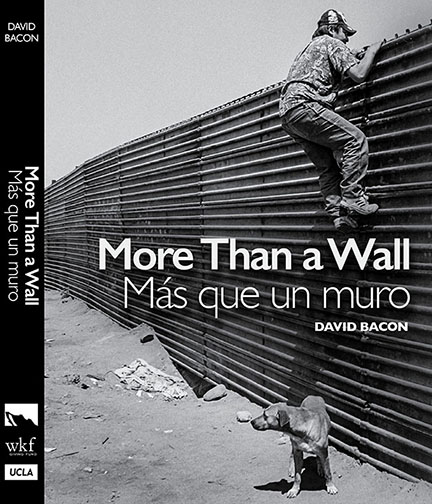 More Than a Wall / Mas que Un Muro explores the many aspects of the border region through photographs taken by David Bacon over a period of 30 years. These photographs trace the changes in the border wall itself, and the social movements in border communities, factories and fields. This bilingual book provides a reality check, to allow us to see the border region as its people, with their own history of movements for rights and equality, and develop an alternative vision in which the border can be a region where people can live and work in solidarity with each other. - Gaspar Rivera-Salgado David Bacon has given us, through his beautiful portraits, the plight of the American migrant worker, and the fierce spirit of those who provide and bring to us comfort and sustenance. -- Lila Downs Published by El Colegio de la Frontera Norte with support from the UCLA Institute for Labor Research and Education and the Center for Mexican Studies, the Werner Kohlstamm Family Fund, and the Green Library at Stanford University Price: $35 plus postage and handling To order, click here: https://david-bacon-photography.square.site/product/more-than-a-wall-mas-que-un-muro/1?cp=true&sa=true&sbp=false&q=false "The "border" is just a line. It's the people who matter." - JoAnn Intili, director, The Werner-Kohnstamm Family Fund IN THE FIELDS OF THE NORTH / EN LOS CAMPOS DEL NORTE 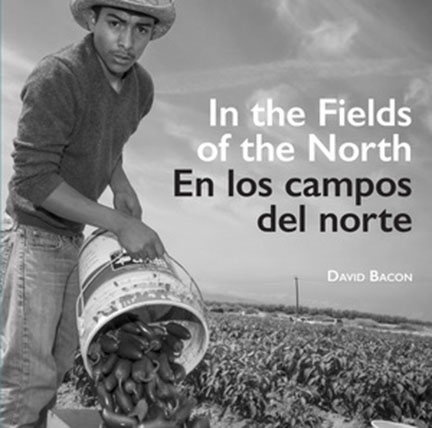 Photographs and text by David Bacon University of California Press / Colegio de la Frontera Norte 302 photographs, 450pp, 9”x9” paperback, $34.95 (in the U.S.) order the book on the UC Press website: ucpress.edu/9780520296077 use source code 16M4197 at checkout, receive a 30% discount En Mexico se puede pedir el libro en el sitio de COLEF: https://www.colef.mx Los Angeles Times reviews In the Fields of the North / En los Campos del Norte - click here  WORK AND SOCIAL JUSTICE: The David Bacon Archive exhibition at Stanford Libraries https://exhibits.stanford.edu/bacon/browse Exhibited throughout the pandemic in the Cecil H. Green Library at Stanford. The online exhibition (https://exhibits.stanford.edu/bacon), which includes additional content not included in the physical show, is accessible to everyone, and is part of an accessible digital spotlight collection that includes significant images from this body of work. For a catalog: (https://web.stanford.edu/dept/spec_coll/NonVendorPubOrderform2017.pdf) Red Lens Episode 6: David Bacon on US-Mexico border photography Brad Segal: On episode 6 of Red Lens, I talk with David Bacon. David Bacon is a California-based writer and documentary photographer. A former union organizer, today he documents labor, the global economy, war and migration, and the struggle for human rights. We talk about David's new book, 'More than a Wall / Mas que un muro' which includes 30 years of his photography and oral histories from communities & struggles in the U.S.-Mexico border region. https://www.youtube.com/watch?v=Nvs6SyXsM-4 Host Mitch Jeserich interviews David Bacon, a photojournalist, author, broadcaster and former labor organizer. He has reported on immigrant and labor issues for decades. His latest book, More Than A Wall, is a collection of his photographs of the border and border communities spanning three decades. Exploitation or Dignity - What Future for Farmworkers UCLA Latin American Institute Based on a new report by the Oakland Institute, journalist and photographer David Bacon documents the systematic abuse of workers in the H-2A program and its impact on the resident farmworker communities, confronted with a race to the bottom in wages and working conditions. https://www.youtube.com/watch?v=UXKa2lHJXMs David Bacon on union solidarity with Iraqi oil worker unions Free City Radio - CKUT 27/10/2021 - https://soundcloud.com/freecityradio/oct-27-2021-ckut-27102021-david-bacon-on-union-solidarity-with-iraqi-oil-worker-unions Organizing during COVID, the intrinsic value of the people who grow our food Sylvia Richardson - Latin Waves Media How community and union organizers came together to get rights for farm workers during COVID, and how surviving COVID has literally been an act of resistance. https://latinwavesmedia.com/wordpress/organizing-during-covid-the-intrinsic-value-of-the-people-who-grow-our-food/ Report Details Slavery-Like Conditions For Immigrant Guest Workers Rising Up With Sonali Kohatkar https://www.oaklandinstitute.org/report-details-slavery-conditions-immigrant-guest-workers The Right to Remain http://www.franknews.us/interviews/415/the-right-to-remain Beware of Pity http://www.franknews.us/interviews/525/beware-of-pity En Español Ruben Luengas - #EnContacto Hablamos con David Bacon de los migrantes y la situación de México frente a los Estados Unidos por ser el principal país de llegada a la frontera de ese país. https://rubenluengas.com/2021/03/video-mexico-estados-unidos-migracion-y-suenos-rotos-encontacto/ Jornaleros agrícolas en EEUU en condiciones más graves por Covid-19: David Bacon SomosMas99 con Agustin Galo Samario https://www.youtube.com/watch?v=YWQSvM9s1lw "Los fotógrafos tomamos partido" Entrevista por Melina Balcázar Moreno - Milenio.com Laberinto http://www.milenio.com/cultura/laberinto/david_baconm-fotografia-melina_balcazar-laberinto-milenio_0_959904035.html David Bacon comparte su mirada del trabajo agrícola de migrantes mexicanos en el Museo Archivo de la Fotografia http://www.cultura.cdmx.gob.mx/comunicacion/nota/0038-18 Online Photography Exhibitions Documentary Matters - View from the US Social Documentary Network Four SDN photographers explore themes of racial justice, migration, and #MeToo https://www.youtube.com/watch?v=fWl-uENA7SQ&t=1641s There's More Work to be Done Housing Assistance Council and National Endowment for the Arts This exhibition documents the work and impact of the struggle for equitable and affordable housing in rural America, inspired by the work of George “Elfie” Ballis. https://www.thereismoreworktobedone.com/david-bacon Dark Eyes A beautiful song by Lila Downs honoring essential workers, accompanied by photographs https://www.youtube.com/watch?v=bdC2gE3SNWw A video about the Social Justice Photography of David Bacon: https://drive.google.com/file/d/14TvAj5nS08ENzWhw3Oxra4LMNKJCLF4z/view In the FIelds of the North Online Exhibit Los Altos History Museum https://www.losaltoshistory.org/exhibits/in-the-fields-of-the-north/ Virtual Tour - In the Fields of the North History Museum of Tijuana Recorrido Virtual de la Exposicion - En los campos del norte Museo de Historia de Tijuana https://www.facebook.com/542258639265202/videos/659536991515786 THE REALITY CHECK - David Bacon blog Other Books by David Bacon - Otros Libros Illegal People -- How Globalization Creates Migration and Criminalizes Immigrants (Beacon Press, 2008) | |
Copyright © 2024 David Bacon Photographs and Stories, All rights reserved. you're on this list because of your interest in david bacon's photographs and stories Our mailing address is: David Bacon Photographs and Stories address on request Oakland, Ca 94601 | |